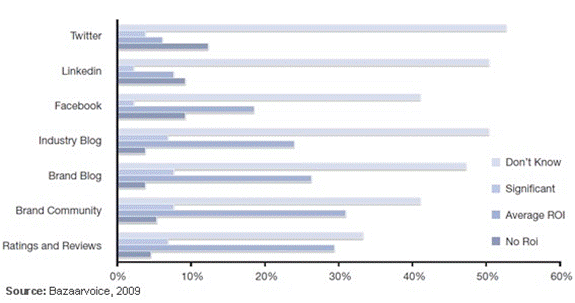Creating a Social Media Analytics Action Plan – Part 1: Defining KPIs
Last week I spoke at PubCon South on the Analytics Strategy panel on the topic of social media. This is something I’m very passionate about and during my preparation for the presentation I uncovered some scary statistics.According to a survey conducted by BazaarVoice in 2009, on average businesses have no idea what their ROI is on any type of social media activity:

Here are a few of the lowlights highlights:
- 53% of respondents are unsure about their return on Twitter
- 50% are unsure about the direct value of LinkedIn
- 50% are not sure how to measure the impact on business metrics from blogs
Part of the problem is they aren’t properly analyzing their data. Social networks are giving us more and more insight into visitor and performance metrics, but most of us aren’t properly setup to find actionable insights on the campaign’s performance.
This series of posts will explain how to properly setup your social media strategy so that you can make better-informed decisions, understand your ROI and adjust your strategy according to the numbers.
Let’s get started. Before you do anything else, you need to have a clear understanding of what your goal will be and how you will measure the success of your social media strategy. In other words, we need to define KPIs.
There are a couple of guidelines you should follow when definining KPIs:
- Choose metrics that actually translate into business context (e.g. sales, new leads, customer satisfaction, customer interaction, etc.)
- Define more than just attention metrics
(You want to look at more important metrics than just your fan/follower count) - Define KPIs that are actionable
(How does knowing what your retweet reach is help you adjust your Twitter strategy?) - Create specific KPIs for each social network and specific elements of your website
- Number of people in a specific location who follow your company on Twitter
- Reduction in sales cycles
- Reduction in support costs
- Increase in product reviews
- Product improvement suggestions from [specific social network]
Source:
Creating a Social Media Analytics Action Plan – Part 1: Defining KPIs
No comments:
Post a Comment